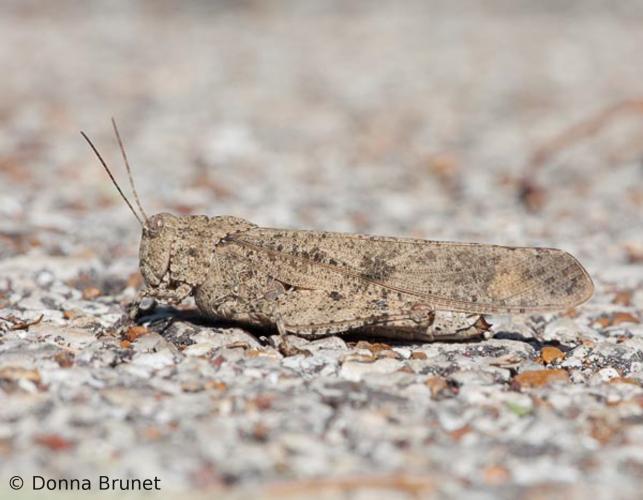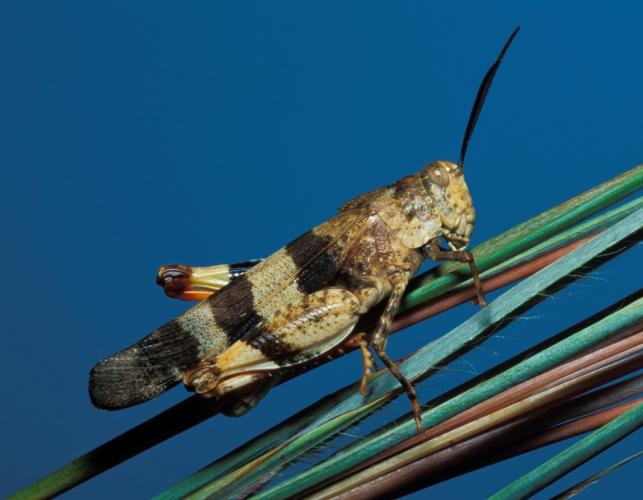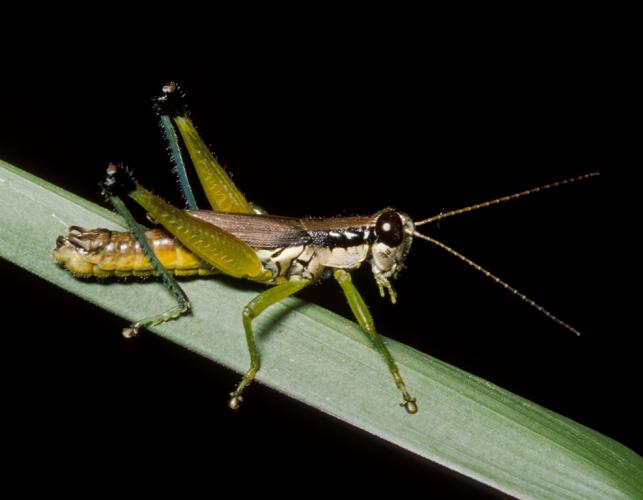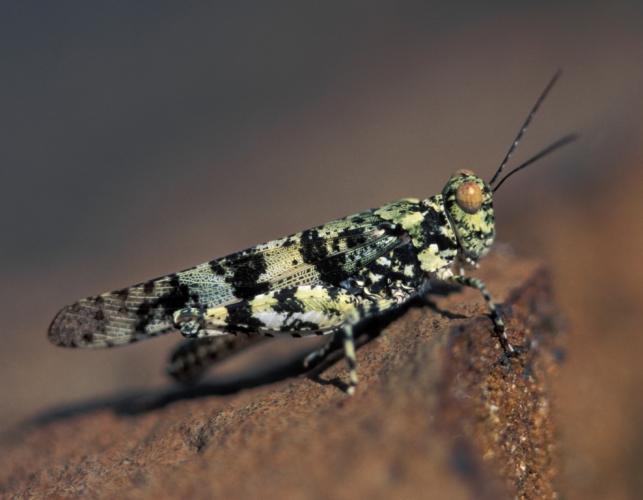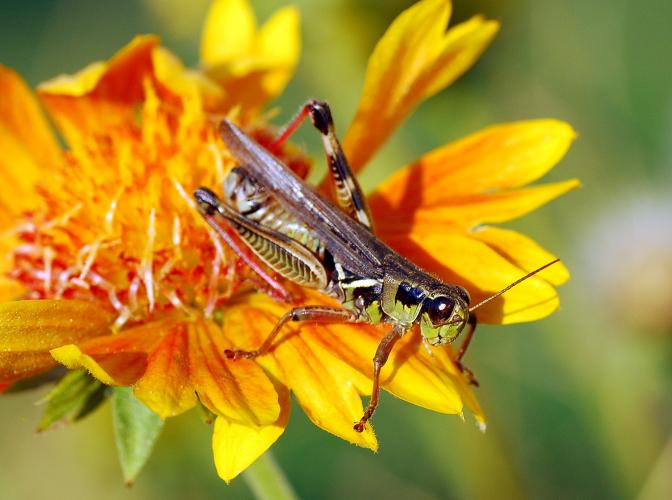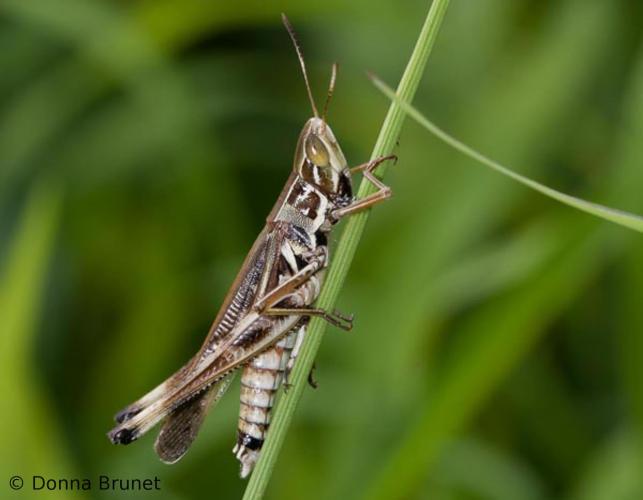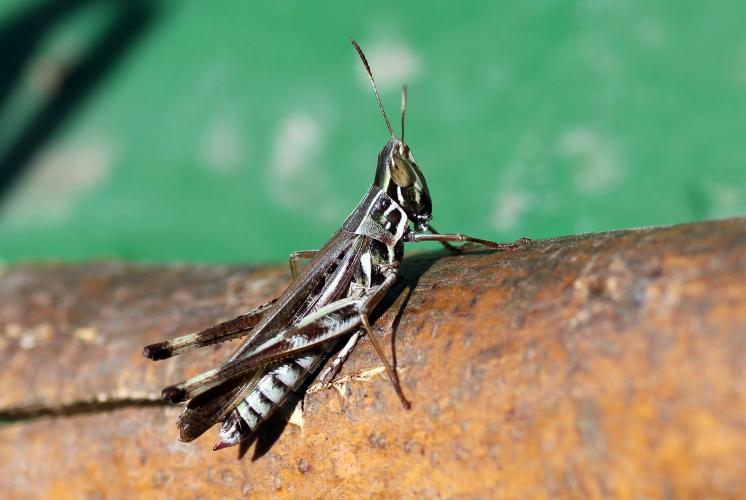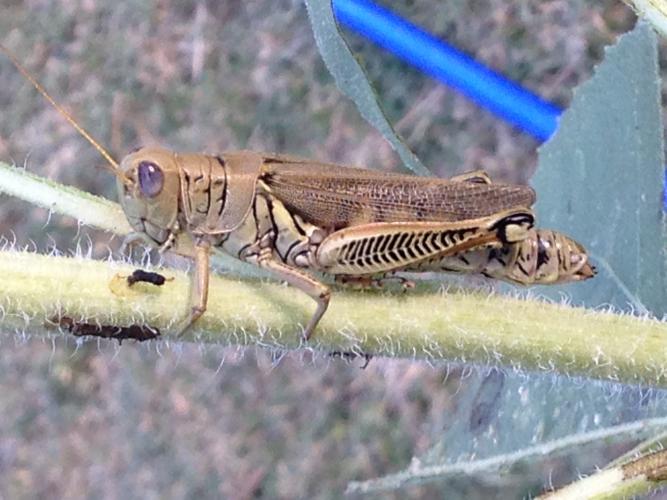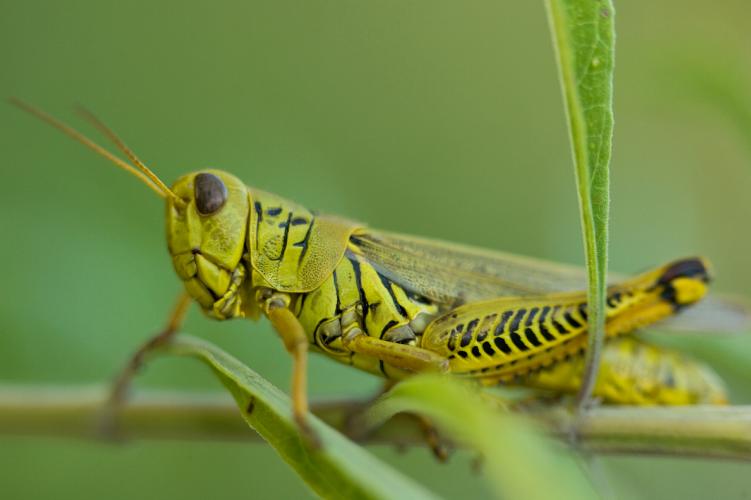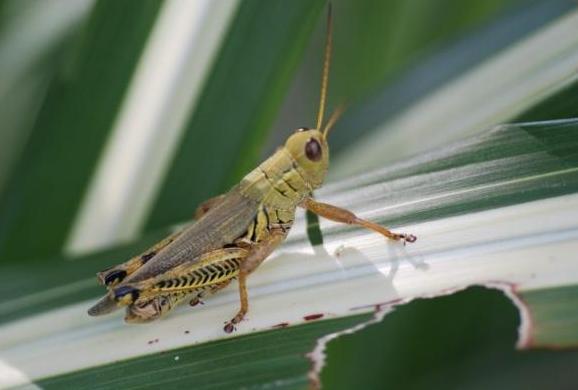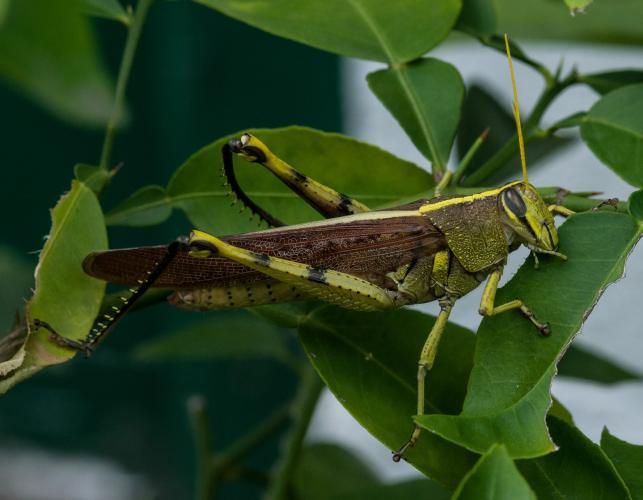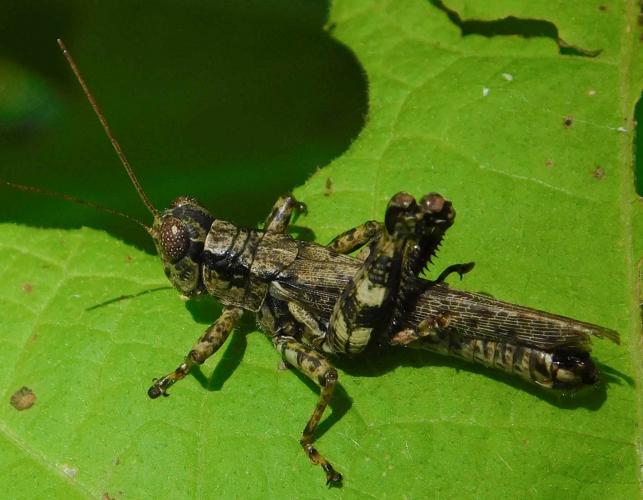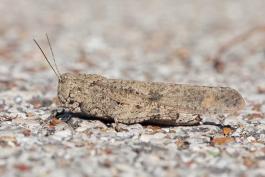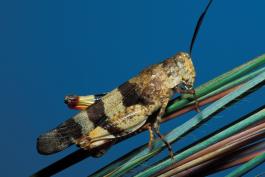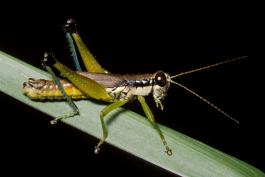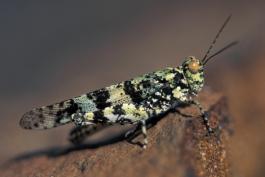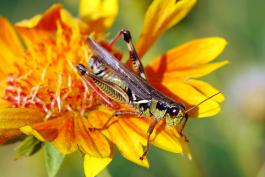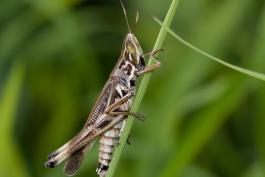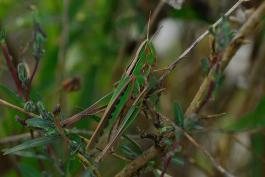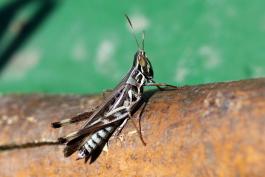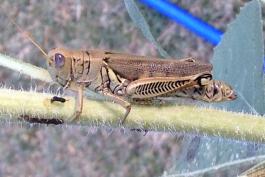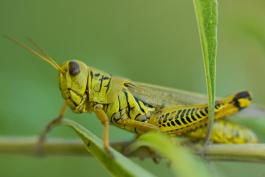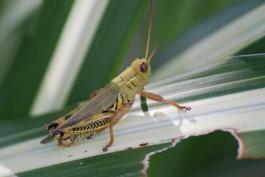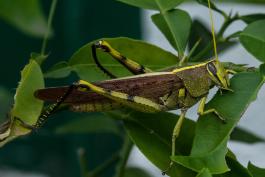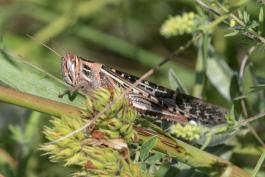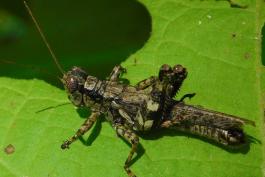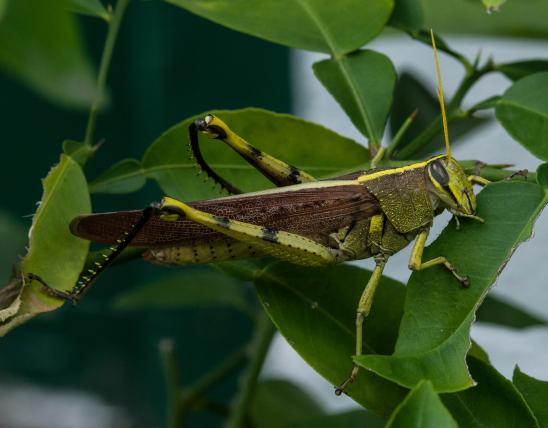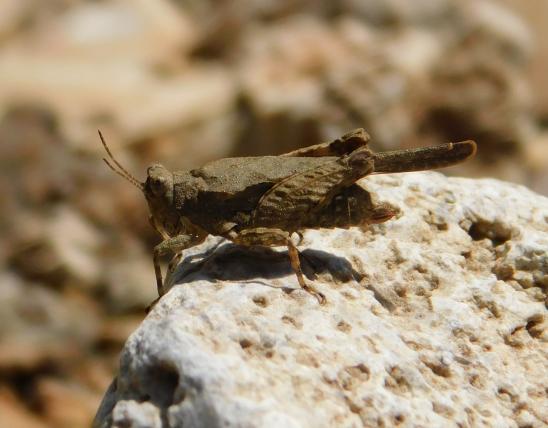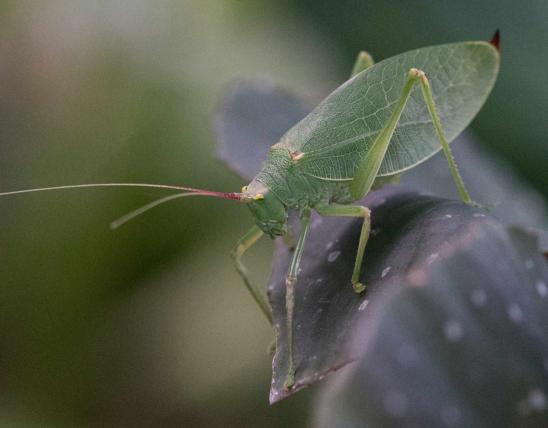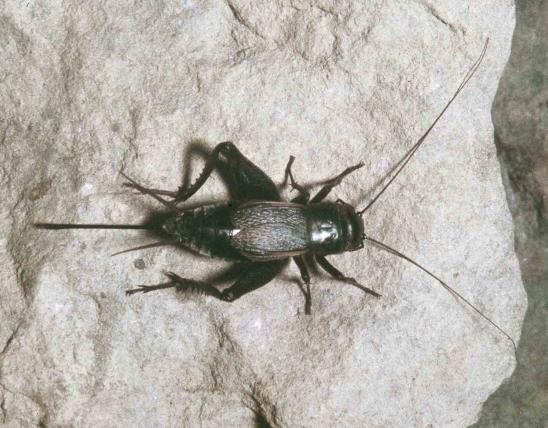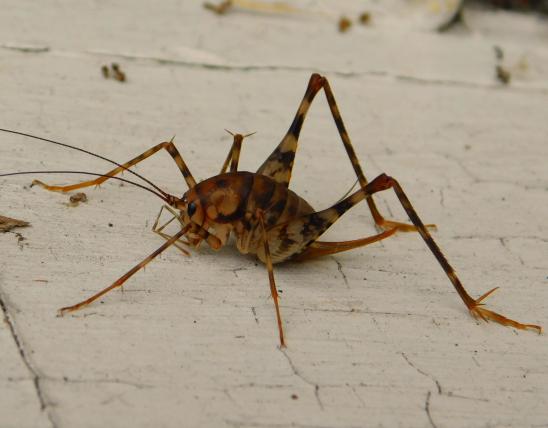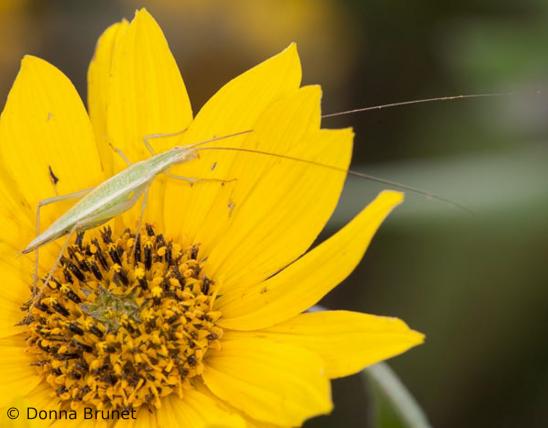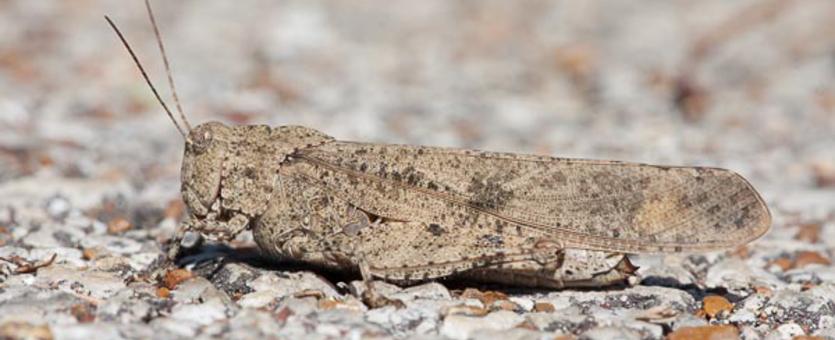
The short-horned grasshopper family includes many familiar jumpers. They are named for their antennae, which are relatively short compared to those in the "long-horned" (katydid) group. The antennae are usually less than half the length of the body and have fewer than 30 segments. Most short-horned grasshoppers are camouflaged with green, olive, tan, brown, or black, though some are quite colorful. Some have colorful wings that only show in flight. The hind legs are specialized for jumping, the mouthparts for chewing.
Like other members of order Orthoptera, short-horned grasshoppers have the first pair of wings long, narrow, fairly thick, and many-veined, functioning as a cover for the second pair, which are membranous and used for flying.
Major Subfamilies or Tribes
Taxonomists have proposed different ways of sorting the subfamilies or tribes of short-horned grasshoppers, but some of the major, well-known divisions are these:
Band-winged grasshoppers have colorful hindwings, usually with a dark band that parallels the outer edge of the wing. They may be mistaken for butterflies, and they often make crackling, buzzing, or ticking sounds as they fly. The pronotum (shieldlike structure between head and wings) is keeled lengthwise (ridged like a rooftop), and its hind edge is strongly triangular, pointed toward the tail. There is no "spur" on the "throat" (as in the spur-throated grasshoppers). The face is fairly vertical (not very slanted). They are usually called subfamily Oedipodinae. A common representative is the Carolina grasshopper (Dissosteira carolina), whose outspread yellow-bordered, black hindwings look like a mourning cloak butterfly. Another is the three-banded grasshopper (Hadrotettix trifasciatus), common in rocky places with little vegetation; it has pale yellow, black-banded hindwings, and the hindlegs have bold yellow-and-black-patterned femurs and bright reddish-orange tibias.
Spur-throated grasshoppers have a small spine or pointed bump on the prosternum (the "throat," situated between the front legs). On the dorsal side ("back" or "top") of the pronotum (the shieldlike structure between the head and the wings), the hind edge is broadly rounded and not sharply triangular; also, the pronotum is not keeled (ridged like a rooftop). The face is fairly vertical (not very slanted). The hindwing is usually clear (not colorful). They have been placed in subfamily Melanoplinae, Cyrtacanthacridinae, or Catantopinae. A common representative is the differential grasshopper (Melanoplus differentialis), with its yellowish olive-green coloration and herringbone-patterned hind legs.
Bird grasshoppers have often been grouped with the closely related spur-throated grasshoppers. There is only one genus, Schistocera, infamous for an Old World swarming "locust" species that was mentioned in the Bible. Our New World species don't swarm, however. Often large, birdlike in flight, they have a "spur throat" and other anatomical details that help identify them from other groups of short-horned hoppers. They have been placed in subfamily Cyrtacanthacridinae, Catantopinae, and Melanoplinae. A common representative is the obscure bird grasshopper (S. obscura), with its reddish-brown forewings, green legs, and pale yellowish stripe running down the back.
Slant-faced grasshoppers are named for the pointed, slanted head that most of them have. Other characteristics include a file on the inside femur of the hind leg that is rasped against raised veins on the forewing, producing sound. They lack a well-developed spur on the prosternum, and most have hind wings that are not strongly colored. They have been placed in subfamily Gomphocerinae, Acridinae, and more. Common representatives include the admirable grasshopper (Syrbula admirabilis), and ornately patterned species whose females are large and grass green and males are smaller and grayish brown or tan.
Two other subgroups, less common in our area, are lubber grasshoppers and spur-throat toothpick grasshoppers.
Length: Most are ½ to 1 inch, but some species can reach 3 inches in length.
Statewide.
Habitat and Conservation
Short-horned grasshoppers live in a variety of habitats, but most live in grasslands and other open habitats. They almost all eat the leaves of plants, so they are found in places with the types of vegetation they prefer.
Food
Some short-horned grasshoppers are specialists, eating only certain types of related plants, while many others are generalists, eating all kinds of leafy plants and grasses. Sometimes they scavenge from dead insects or eat decaying plant matter, especially when fresh leaves are scarce.
Status
Approximately 13 species of short-horned grasshoppers are Missouri species of conservation concern, meaning that they are either declining or are to some degree vulnerable to being extirpated from our state. These include the oddly shaped cattail toothpick grasshopper (Leptysma marginicollis); 4 are banded-wings, 6 are spur-throated, and 3 are slant-faced.
Many members of the short-horned grasshopper family are considered pests of crops and rangeland.
Life Cycle
Grasshoppers go through simple metamorphosis: after hatching from an egg, their juvenile stages look a lot like the adults. As they eat and grow, they molt their exoskeletons but do not go through a transformative metamorphosis or pupal stage. The final adult stage, however, usually has fully developed wings and is sexually mature. The males of many grasshoppers make sounds that attract females, either rasping legs on stiff forewings or making clacking or buzzing noises in flight. True to the fable, grasshoppers usually only live for a season, then die with the hard freezes in late fall.
Human Connections
Short-horned grasshoppers may plague gardeners, but people also like to use them as fishing bait, and hoppers are also important food for many game animals. Poultry like grasshoppers, too! This group includes some notorious swarming "locusts" from history. One species of bird grasshopper is the one famous for the "plagues of locusts" mentioned in the Bible (that species does not occur in North America, however). The Rocky Mountain locust, infamous for swarming in the West, is extinct.
Ecosystem Connections
Grasshoppers feed countless predators, many of which grow large over the course of the summer just as the grasshoppers do. Newly hatched black-and-yellow garden spiders building their first webs of early summer can capture the small, young grasshoppers appearing at that time, and by season's end, the surviving, large garden spiders are big enough to handle the surviving, fully grown grasshoppers. Many fish, amphibians, reptiles, mammals, and birds eat grasshoppers, too.
